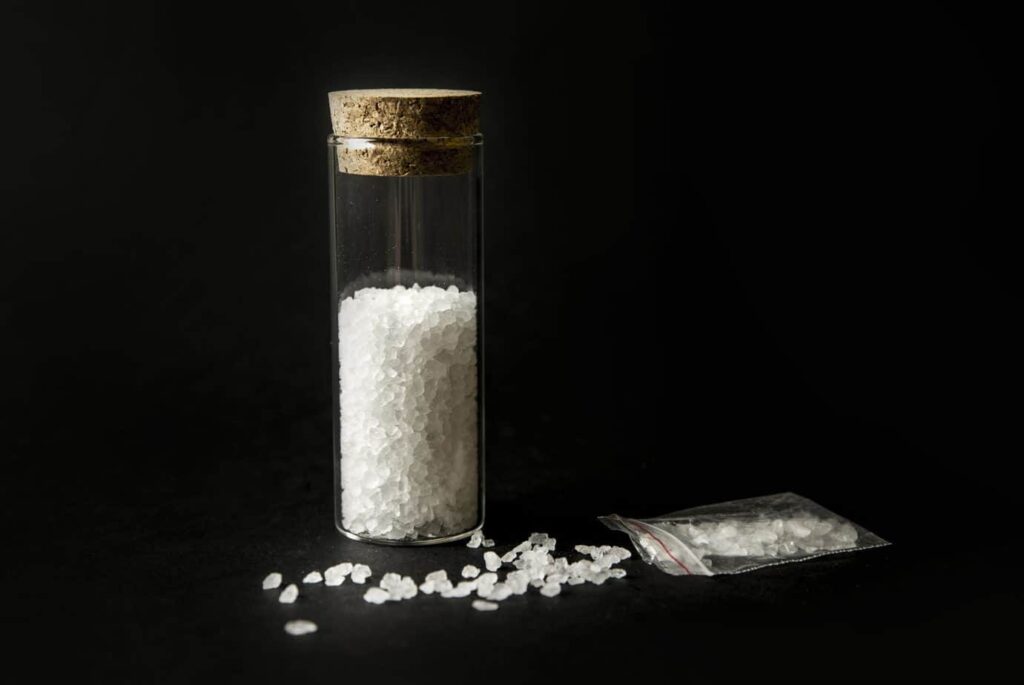Uncategorized
Unveiling the Mysteries of MDPV: What It Stands For, Its Nicknames, Duration in the System, and Connection to Pyrovalerone
Introduction
MDPV, a term that often surfaces in discussions about synthetic drugs and their effects, stands for methylenedioxypyrovalerone. This synthetic stimulant has gained infamy due to its potent effects and association with “bath salts.” This blog post will dive deep into what MDPV stands for, the various names under which bath salts are sold, how long MDPV stays in your system, and its connection to pyrovalerone. By the end of this comprehensive post, you will have a thorough understanding of MDPV and its broader context in the world of synthetic stimulants.
What Does MDPV Stand For?
Understanding the Acronym
MDPV stands for methylenedioxypyrovalerone. This name describes the chemical structure of the compound, which includes a methylenedioxy group and a pyrovalerone backbone. The name itself provides insights into the molecular composition and the pharmacological properties of the substance.
Chemical Structure and Properties
MDPV is a synthetic cathinone, a class of drugs that are chemically similar to naturally occurring cathinones found in the khat plant. Its chemical formula is C16H21NO3, and it has a molecular weight of 275.35 g/mol. MDPV appears as a white or off-white crystalline powder, which can be ingested, snorted, smoked, or injected to produce its stimulant effects.

Other Names for Bath Salts
The Misleading Label
The term “bath salts” is a misleading label used to market a variety of synthetic cathinones, including MDPV. These substances are often sold in small packets labeled as bath salts, plant food, or research chemicals, with disclaimers stating “not for human consumption.” This labeling is intended to circumvent drug laws and regulations.
Common Street Names
Bath salts have a variety of street names, which can vary by region and the specific formulation of the drug. Some of the most common names include:
- Ivory Wave
- Vanilla Sky
- Bliss
- Purple Wave
- Cloud Nine
- White Lightning
- Scarface
- Lunar Wave
These names often evoke a sense of euphoria or otherworldly experiences, enticing users to experiment with the substances.
Chemical Names and Variants
In addition to MDPV, bath salts may contain other synthetic cathinones, such as:
- Mephedrone (4-MMC)
- Methylone (bk-MDMA)
- α-PVP (alpha-Pyrrolidinopentiophenone)
- Butylone (bk-MBDB)
Each of these compounds has its own unique effects and potential risks, contributing to the unpredictable nature of bath salts.
How Long Does MDPV Stay in Your System?
Metabolism and Excretion
The duration that MDPV stays in the system depends on several factors, including the dose, frequency of use, metabolism, and the method of administration. MDPV is metabolized primarily in the liver and excreted through the kidneys in urine.
Detection Windows
The detection windows for MDPV in various biological samples are as follows:
- Urine: MDPV can be detected in urine for up to 48-72 hours after use. In cases of heavy or chronic use, it may be detectable for a longer period.
- Blood: MDPV is typically detectable in blood for up to 24 hours after use.
- Saliva: Saliva tests can detect MDPV for up to 24-48 hours after use.
- Hair: Hair follicle tests can detect MDPV for up to 90 days or more, providing a long-term history of use.
Factors Influencing Duration
Several factors can influence how long MDPV stays in your system, including:
- Dosage: Higher doses may result in longer detection times.
- Frequency of Use: Regular use can lead to accumulation in the body, extending the detection window.
- Metabolism: Individual differences in metabolism can affect how quickly MDPV is processed and eliminated.
- Hydration: Hydration levels can influence the excretion rate of MDPV in urine.
Pyrovalerone: The Precursor to MDPV
What is Pyrovalerone?
Pyrovalerone is a stimulant drug that was first synthesized in the 1960s. It was initially developed for medical use as a treatment for chronic fatigue and as an appetite suppressant. Pyrovalerone acts as a norepinephrine-dopamine reuptake inhibitor (NDRI), similar to MDPV, enhancing the levels of these neurotransmitters in the brain and producing stimulant effects.
Chemical Relationship to MDPV
MDPV is structurally related to pyrovalerone, with the primary difference being the addition of a methylenedioxy group to the chemical structure of pyrovalerone. This modification enhances the potency and psychoactive effects of MDPV compared to pyrovalerone. Both substances share similar mechanisms of action, but MDPV is considered to be more potent and has a higher potential for abuse and adverse effects.
Historical Context and Usage
Pyrovalerone was used medically for several decades but fell out of favor due to concerns about its potential for abuse and dependence. It was eventually classified as a controlled substance in many countries. The synthesis of MDPV and other synthetic cathinones in the early 2000s was partly inspired by the pharmacological properties of pyrovalerone, leading to the development of more potent and dangerous stimulants.
Effects and Risks of MDPV
Desired Effects
MDPV is sought after for its powerful stimulant effects, which can include:
- Euphoria: Intense feelings of pleasure and well-being.
- Increased Energy: Enhanced physical and mental energy levels.
- Alertness: Improved focus and concentration.
- Sociability: Increased sociability and talkativeness.
Adverse Effects
Despite its desirable effects, MDPV is associated with a range of adverse effects, including:
- Anxiety and Paranoia: Intense feelings of anxiety and paranoia, often leading to panic attacks.
- Psychosis: Hallucinations, delusions, and other psychotic symptoms.
- Insomnia: Difficulty sleeping or maintaining a regular sleep pattern.
- Agitation: Restlessness and irritability.
- Cardiovascular Issues: Elevated heart rate, increased blood pressure, and risk of heart attack or stroke.
Long-Term Effects
Prolonged use of MDPV can lead to severe health consequences, including:
- Addiction: MDPV has a high potential for addiction, leading to compulsive drug-seeking behavior.
- Cognitive Impairment: Long-term use can result in memory problems, cognitive deficits, and impaired decision-making.
- Mental Health Disorders: Increased risk of developing anxiety, depression, and other mental health disorders.
- Physical Health Decline: Chronic use can lead to weight loss, malnutrition, and overall physical health deterioration.
Case Studies and Incidents
Notable Incidents
Several high-profile incidents involving MDPV have underscored its dangers. One of the most widely reported cases occurred in 2012, when a man in Florida attacked a homeless individual while under the influence of MDPV, exhibiting extreme aggression and violent behavior. This incident, often referred to as the “Miami Zombie” case, brought national attention to the dangers of bath salts.
Health and Safety Risks
The use of MDPV poses significant health and safety risks, both to the individual user and to the public. The unpredictable nature of its effects, combined with the potential for severe mental health disturbances, makes it a particularly dangerous substance.
Emergency Room Visits and Toxicity
MDPV use has been associated with a substantial increase in emergency room visits due to acute toxicity. Symptoms of MDPV toxicity can include severe agitation, hyperthermia, seizures, and cardiovascular collapse. Medical professionals often face challenges in managing these cases due to the rapid onset and intensity of symptoms.
Understanding the Appeal
Why Do People Use MDPV?
Despite the known risks, some individuals are drawn to MDPV for its powerful stimulant effects. The desire for increased energy, euphoria, and sociability can drive people to experiment with this substance, especially in social or party settings.
Misleading Marketing and Accessibility
The marketing of MDPV as “bath salts” or “plant food” has contributed to misconceptions about its safety. These products are often sold in attractive packaging, with misleading labels suggesting they are safe for use. Additionally, the ease of access through online marketplaces and retail stores has made MDPV readily available to a wide audience.
Peer Influence and Curiosity
Peer influence and curiosity play significant roles in the initiation of MDPV use. Social circles that condone or encourage drug use can pressure individuals to try MDPV, while the desire to experience its effects firsthand can lead to experimentation.
Treatment and Recovery
Addressing MDPV Addiction
Treating MDPV addiction requires a comprehensive approach that addresses both the physical and psychological aspects of dependence. Detoxification, behavioral therapy, and counseling are essential components of a successful treatment plan.
Detoxification and Medical Management
Detoxification involves the gradual removal of MDPV from the body while managing withdrawal symptoms. Medical supervision is crucial during this process to ensure the safety and well-being of the individual.
Behavioral Therapy and Counseling
Behavioral therapy and counseling aim to address the underlying psychological factors contributing to MDPV addiction. Cognitive-behavioral therapy (CBT) is
